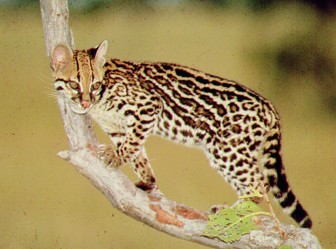The Margay (Leoparduswiedii), like its cousin the Oncilla, is a rare and elusive small spotted cat that lives in the remote parts of the rainforest. Their range runs from Central to South America; Mexico south to Uruguay and Argentina. They are similar to the Ocelot in appearance and in some areas are known as the “Climbing Ocelot”. The Margay differs from the Ocelot as the head is shorter, the eyes are larger, and the tail and legs are longer. Margay fur is brown with numerous rows of tan or black rosette and longitudinal stripes; in the neck area they are reversed. The belly is pale and the tail is banded and tipped black.
Margays are nocturnal and solitary creatures. They are good jumpers and climbers. They are one of two cat species that can rotate their ankle joints to climb down a tree head first (the other is the Cloud Leopard which only exists in the Himalayas in Asia). Margays may spend much of their lives in trees, though they come down to the ground to cross wide areas. In the trees they hunt birds, monkeys, tree frogs, lizards, eggs and other small mammals. It is said that they use auditory mimicry to lure prey.

Margays breed year round; one to two kittens are born per pregnancy. The kits are weaned eight weeks from birth and by this time they also know how to hunt small prey like insects, frogs and lizards. Kits need to be independent quickly as they are easily preyed on. Margays are sexually mature by two years old. Because they are so rare Margays were once thought to be extinct in parts of their range. The IUCN has now reassessed their population status and they are listed as near threatened. CITES lists the species as Appendix I.
Rain forests are rich in biodiversity and are home to many different plants and animals as well as indigenous communities. Humans, even those who don’t live in the rain forest, rely on it for resources such as building materials (wood and lianas), medicine and fruits. Rain forests also provide essential environmental services for life on earth; they create soil as well as prevent soil erosion, produce oxygen though photosynthesis, maintain clean water systems, and are a key defence against climate change.
The Iwokrama Rain Forest is 371,000 hectares, located in the heart of Guyana. Our mission is to develop strategies for conservation and sustainable development for local people in Guyana and the world at large. We are involved in timber, tourism and training. Come and visit us in the rain forest or at http://www.iwokrama.org.





